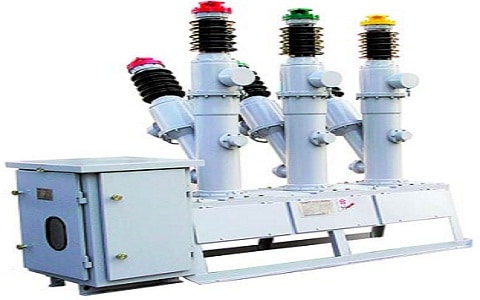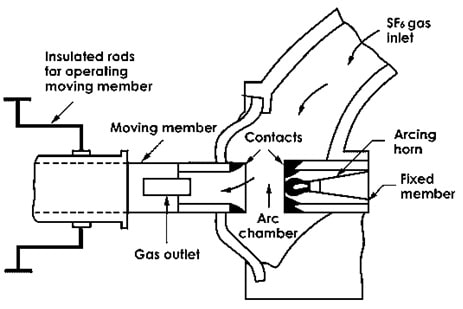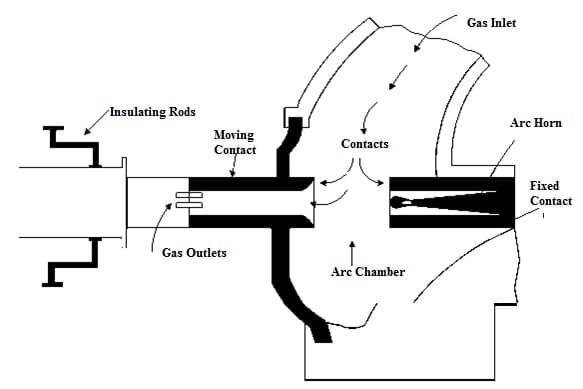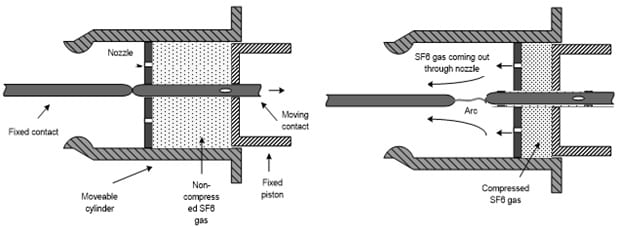A circuit breaker is one type of protection device used to give protection to the electrical system against fault currents. The main function of the circuit breaker is to stop the flow of current to guard equipment by preventing fire risk. There are different types of circuit breakers. A circuit breaker is significant in electrical systems for security & reliability. If any fault happens, the circuit breaker protects people against electrical shocks and also prevents fire hazards, power outages & equipment damage. There are different kinds of circuit breakers available in the market like vacuum, Sulfur hexafluoride, oil, ground fault, molded-case, miniature, earth leakage, high voltage, and many more. So, the sulfur hexafluoride (SF6 circuit breaker) is one of the main types of CBs which uses the arc quenching medium like SF6 gas to securely break the high voltage circuit. This article discusses an overview of the SF6 circuit breaker, its working & its applications.
What is SF6 Circuit Breaker?
A type of circuit breaker (CB) that uses pressurized dielectric gas like SF6 to extinguish the arc is known as an SF6 circuit breaker. This gas has superior arc quenching & insulating properties as compared to oil or air. SF6 gas has extremely higher electronegativity and also a very strong tendency for absorbing free electrons. As compared to other types of circuit breakers, these CBs have been found to be extremely efficient for high voltage & high power service. So these are utilized within substations for all range of voltages which ranges from 144 kV to 765 kV. The SF6 circuit breaker pressure level is maintained at 6.5 bar.

SF6 Circuit Breaker
Properties
The properties of the sulfur hexafluoride circuit breaker are discussed below.
- Sulfur hexafluoride gas is non-toxic, non-inflammable, odorless & colorless.
- SF6 gas is very stable, immobile & its density is more than air.
- The thermal conductivity of this is better as compared to air.
- It is electronegative powerfully so that free electrons can be removed very easily from discharge through the negative ions formation.
- It is very effective hundred times as contrasted to arc quenching medium.
- As compared to air, its dielectric strength is 2.5 times better and less than 30% of dielectric oil.
- The dielectric strength of SF6 gas will increase at maximum pressure.
- For SF6 CB, moisture is extremely harmful because a combination of SF6, hydrogen fluoride & humidity forms can attack the CB parts.
- It is pressure-dependent because it liquefies at less temperature.
- The dielectric strength cannot be affected by the frequency of the voltage.
- These are non-corrosive.
SF6 Circuit Breaker Construction
The construction of the SF6 circuit breaker is shown below. This circuit breaker includes two contacts namely fixed and movable which are enclosed within a chamber. This chamber is also known as the arc interruption chamber which contains SF6 gas. This interruption chamber is connected simply to the SF6 gas reservoir. Once the circuit breaker contacts are opened, then the mechanism of the valve allows a high-pressure SF6 gas using the gas reservoir to supply in the direction of the arc interruption chamber.

SF6 Circuit Breaker Construction
The fixed contact within the circuit breaker is a hollow cylindrical connection throughout an arcing horn. The moving contact is a hollow cylinder including rectangular holes within the sides which allow the SF6 gas to emit throughout these holes once supplied next to & across the arc.
In the circuit breaker, the tips of two contacts and also arcing horn are covered with copper-tungsten material. Since Sulfur hexafluoride gas is expensive, it is cleaned and regained by an appropriate auxiliary system once every circuit breaker operation.
Working Principle
In the SF6 CB, the contacts in the closed position stay enclosed through SF6 gas at about 2•8 kg/cm2 pressure. Whenever the circuit breaker functions, the moving contact will be pulled separately & an arc is struck among the two contacts. So, the moving contact’s movement is synchronized by the valve opening that allows the gas at 14 kg/cm2 force from the gas reservoir toward the arc interruption chamber.
The flow of high-pressure SF6 gas absorbs the free electrons rapidly within the arc lane to form static negative ions which are not effective like charge carriers. So the medium among the two contacts builds up high dielectric force quickly & causes arc extinction. After the operation of SF6 CB, the valve is clogged through a set of springs action.
Types of SF6 Circuit Breaker
There are two types of SF6 circuit breakers like non-puffer type and single-pressure Puffer type which are discussed below.
Non-Puffer type SF6 CB
The first type of SF6 Circuit Breaker is a Non-puffer type that does not contain the puffer cylinder. So this kind of SF6 CB works similarly to an air blast type circuit breaker. This circuit breaker includes a gas chamber & also an interrupter unit. In the gas chamber, the SF6 gas is squeezed & also stored and it is connected to the interrupter unit through a valve. The valve within the circuit breaker is linked by the contact’s movement. Once the contacts divide, the valve will be opened to discharge a blast of SF6.
The contacts of this circuit breaker in normal conditions remain closed & the compressed SF6 gas stays within the gas chamber. Once any fault happens, then contacts will start to move & disconnect from the fixed contact. Here the surrounding medium of the contacts will get ionized & an arc can be produced in between the contacts.

Non Puffer SF6 circuit breaker
Simultaneously, the valve of the gas chamber will open & release the pressurized SF6 gas into the arc chamber. This gas quenches the arc & the blast of SF6 also cools the arc. The SF6 gas flows out throughout the opening wherever the SF6 gas is recombined. For reuse, the gas can be recompressed & also stored within the gas chamber. Here the gas system is completely enclosed & it is monitored constantly for any leak.
Single Pressure Puffer Type
The single-pressure puffer-type SF6 CB mainly comprises the puffer cylinder which is a changeable hollow cylinder that works like a bridge in between the two fixed contacts. It simply slides axially upward & downward along the contacts for making & breaking the contact between the two fixed contacts. This circuit breaker includes two fixed contacts with a small gap in between them & a puffer cylinder in this CB is filled with SF6 gas which is arranged on top of it.
This circuit breaker has a stationary piston within the puffer cylinder. When the cylinder moves then the cylinder volume will change because of the fixed piston. The piston pushes on the SF6 gas will increase its pressure whenever the pressure is also increased by using the arc energy.

Single Pressure Puffer Type
The puffer cylinder has vents and also fixed contacts for the inside and outside of the SF6 gas. In this cylinder, the vents are blocked through the fixed contact where this contact opens once the puffer cylinder moves downside. In fixed contact, the hole is mainly used for the gas inlet once the cylinder moves into the closed place. The moving arm is used to move the cylinder up & down.
The working of this circuit breaker is; the puffer cylinder in normal condition is in a closed location while the connecting bridge is connected in between the two fixed contacts. Here, the puffer cylinder is filled with SF6 gas.
Since the puffer cylinder vents are closed through the fixed contact, then SF6 gas will remain in the cylinder. Once a fault occurs, the puffer cylinder will move down breaking the connection in between the fixed contacts. The medium ionizes & an arc is generated between the contacts. Because of down movement & the inactive piston, the cylinder volume reduces to compress the gas inside. In the cylinder, there are vents that are blocked previously by the higher fixed contact. The vents in the cylinder will open up whenever it moves downward. The compressed gas goes out throughout the vents at high speed. The SF6 gas flow quenches the arc.
Maintenance
Circuit breaker maintenance is required due to their significance in equipment protection & also routine switching. If any circuit breaker doesn’t work properly due to the lack of protective maintenance then the electric transmission system will damage & equipment damage can also occur. Circuit breakers that stay inactive for a minimum of six months or above must be made to open & close numerous times in series to confirm suitable operation & eliminate any dust on contacts & moving parts.
Advantages & Disadvantages
The advantages of the SF6 circuit breaker are discussed below.
- SF6 gas has outstanding insulating and arc extinguishing properties.
- The SF6 gas is stable chemically & non-inflammable.
- It provides noiseless operation.
- It doesn’t have any overvoltage trouble because the arc can be quenched at zero current.
- This circuit breaker needs low maintenance.
- There is no drop within dielectric strength because no carbon particles are created throughout arcing.
- Electric clearance is greatly decreased due to the high dielectric power of SF6.
- It performs a variety of tasks like short-line faults clearing, transformer reactor, switching, and unloaded transmission lines opening without any trouble.
- Its performance cannot be affected because of variations within atmospheric conditions.
The disadvantages of the SF6 circuit breaker are discussed below.
- SF6 gas is expensive so SF6 circuit breakers are expensive.
- The SF6 gas is heavier as compared to oxygen & causes complexity in breathing.
- SF6 leakage from the joints should be monitored continuously.
- It needs special transportation & maintenance for the gas quality.
- The SF6 gas recombination & reconditioning requires extra equipment.
- The inner parts require cleaning throughout periodic maintenance in a clean & dry environment.
- The moisture entrance within the SF6 circuit breaker tank is extremely injurious to the circuit breaker & it causes numerous breakdowns.
- The leakage of byproduct gases formed by SF6 gas during arcing is poisonous for the surroundings.
Applications
The uses or applications of the SF6 circuit breaker are discussed below.
- SF6 circuit breaker is used to protect extremely high voltage circuits equal to 800 kV from error current.
- It is used to break safely & depower high voltage circuits for any type of inspection or maintenance.
- These are used to protect power transmission & distribution systems.
- These are connected within power grids & power generation-based plants.
- These are used in high voltage-based applications.
- These circuit breakers are used in power distribution ad control.
- These are used in power circuits for line protection and also in rectifier circuits.
- These are used in capacitor circuits.
- These CBs are used to protect the transformers.
Why SF6 is used in the breaker?
The SF6 gas is used within the circuit breaker due to its chemical properties. This gas has outstanding thermal transfer characteristics, thus it absorbs the arc energy and forms resistance across the contacts of arcing & ultimately quenches the arc.
What is SF6 used for?
The SF6 is used by approximately 80% of the world for electricity transmission & distribution. High and medium-voltage-based electrical equipment have SF6 gas to protect the electrical parts & also for switching the current flow on & off.
What type of contacts is used in SF6 circuit breakers?
The contacts used in the SF6 circuit breaker are fixed & moving. The fixed contact is fixed with an arcing horn whereas the moving contact is a hollow cylinder including rectangular holes within the sides. These holes allow the SF6 gas to emit throughout them after supplying along & across the arc.
Please refer to this link to know more about Circuit Breaker.
Thus, this is an overview of an SF6 circuit breaker, its construction, its working, and its applications. This circuit breaker utilizes sulfur hexafluoride gas like an arc quenching medium because it has high dielectric strength. SF6 gas is an electro-negative gas that has a high capacity for absorbing free electrons. Here is a question for you, what is a circuit breaker?